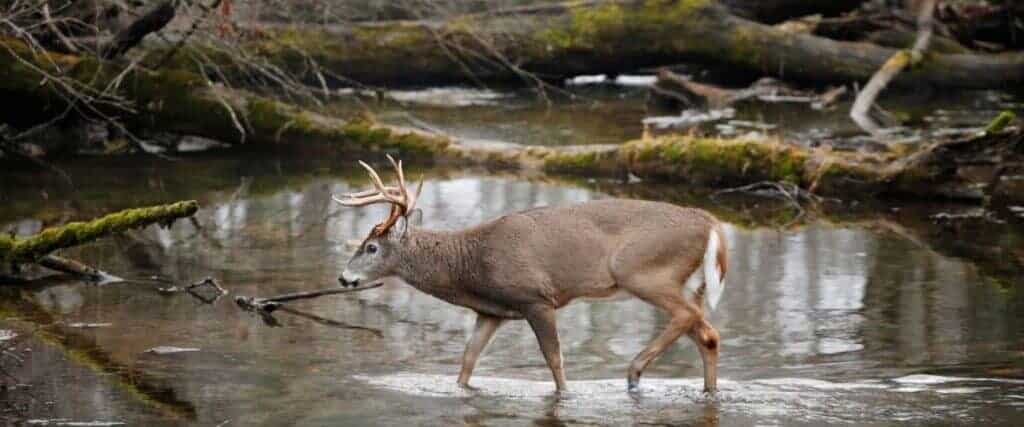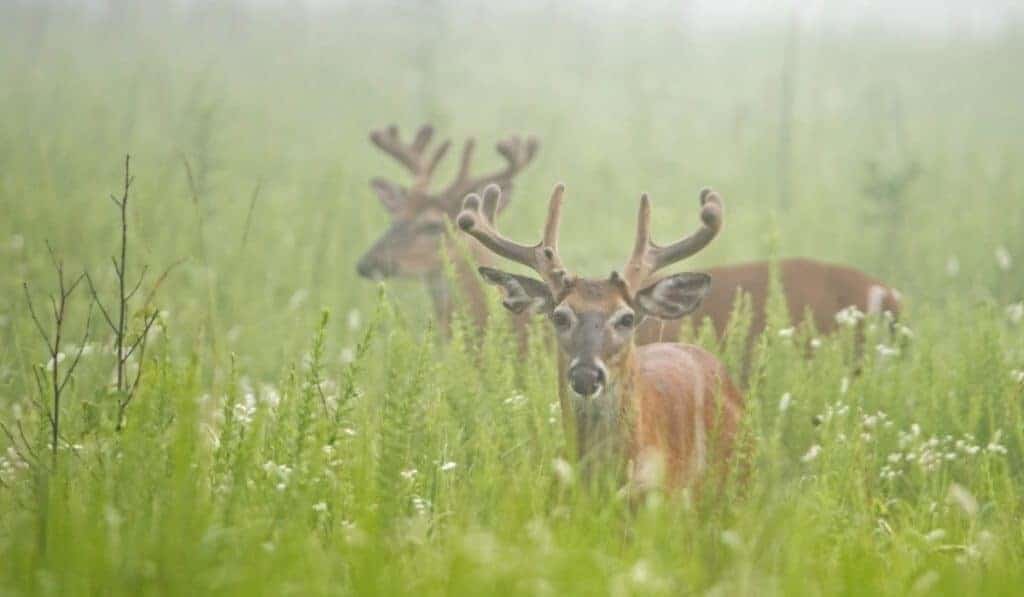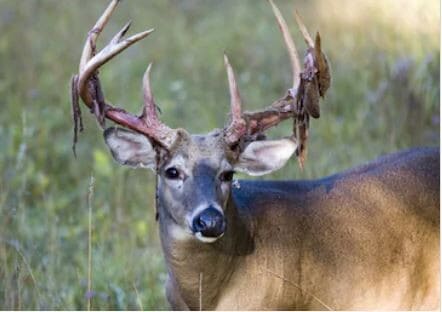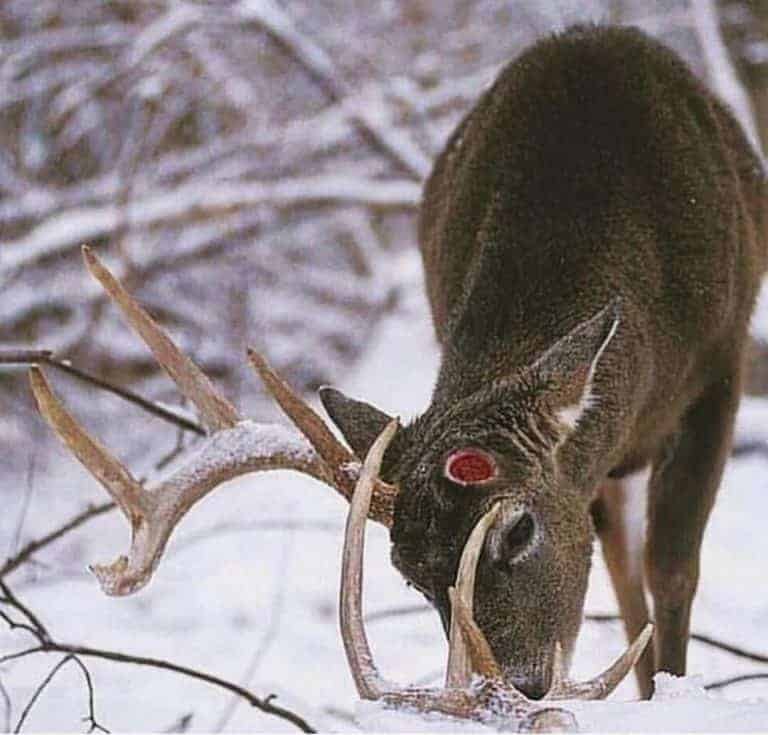Whitetail deer change their behavior and who they travel with depending on the time of year. Sometimes you may see a buck by himself and other times you may see him with three other bucks. As for does, a lot of the time you will see them alone or with their fawns, but we also see them with a group of other does. So what is the difference between these times of the year and when are whitetail solitary?

The Quick Answer
- Spring: Does are giving birth, they may be social or may limit their social groups to themselves and their fawns. Bucks are in bachelor groups.
- Summer: All deer will be in social groups.
- Fall: Does might be in small groups or solitary if in estrus, bucks will be solitary and chasing does in estrus.
- Winter: All deer will gather in larger groups and focus on feeding.
A Breakdown of Solidarity Depending on the Time of Year
Does are the most social sex in whitetails, most of the time that they are solitary is due to a buck breaking up their social groups. Generally, we see does in groups with other does their fawns, and possibly young bucks. Bucks will be solitary for a large portion of the year but they are also very social during times of the year when their testosterone levels are low. So let’s break down the seasons and see when exactly whitetail are or are not solitary.
Spring
During the spring does are having their fawns. For most of the spring, their social group will typically be made up of only them and their fawns. Although it is also not uncommon for multiple does and their fawns to groups up together.
Bucks are generally social during this time. They could be solitary, or in larger groups, but during the tail end of spring they will form their bachelor groups that they will stay with until fall. During the spring bucks are out eating the most nutritious food they can find and are just starting to grow out their new set of antlers.

Summer
During the summer, bucks will be in their bachelor groups. These groups can be very unique, they can consist of anywhere between 2-5 bucks typically. These bucks will not be the same age or class either, some could be 2 years old while others could be 5 years old. Their new antlers are also starting to take shape during this time. During the tail end of summer, their antlers will start to shed their velvet and the hard bone will be exposed underneath.
During the summer, does are more likely to be grouped up with other does and all of their fawns. These groups can consist of any number of does and may also have some young bucks as well. Fawns will start to lose their spots when they are 3-4 months old. So depending on which rut they were conceived in, they will lose their spots in mid to late summer.

Fall
Fall is the best time of the year for a hunter. This is the time of the year that whitetail are breeding called the rut. The rut does not have a concrete time frame and takes place during different times throughout the country, but it will only be different by a few weeks or days. The rut will always be during the fall but how long it lasts and when it starts depends on many factors.
During the rut, bucks become very aggressive and will become solitary. They start to travel more than usual in the search for does that are ready to breed. They will chase these does for hours or days until they give up and succumb to breeding. Through this process groups formed by does are quickly broken up, and many fawns are separated from their mothers. This is not a big deal though. Whitetail fawns are fully developed ruminates and are able to forage for themselves as early as 45 days old.
Winter
During the start of the winter, there may be what we call a second rut. Sometimes does are not quite ready to be bred during the fall, most of the time these does are the fawns that were born the spring before. Whitetail does only need to be 6 months old to become sexually mature. so about halfway through December, there is another rut that lasts only a week or two.
After the rut, deer have used up a lot of their stored nutrients, so they form much larger deer herds and focus heavily on feeding. Buck testosterone levels start to drop so they become less aggressive and more social. This also sends signals to specialized cells at the base of their antlers and lets them know that it is time to shed them. After bucks have shed their antlers, they will focus on eating enough to recover essential nutrients spent during the rut, and then they will start to grow more antlers in the spring.

This also creates a mini-sport for hunters that are already missing the woods called shed hunting. Hunters will go out into the woods again in search of these antlers that have fallen off. For most, it is a fun pastime or hobby, but for others, it can be an effective management strategy to find out which bucks made it through the hunting season.
Conclusion
So as I mentioned, how social whitetail are depends on the time of year. You can also see that bucks and does behave differently during the same times of the year. During the spring both sexes are generally social though they may for many different types of groups. During the summer whitetail are very social. They for large doe groups, and buck bachelor groups. Fall is a different story. The rut comes in the fall and then whitetail bucks become very aggressive and separate from their groups and break up doe groups by chasing does for breeding. Both sexes are solitary during this time. Though does will try to stick with last years’ fawns, they often get separated. During the winter whitetail are very social and their top priority is recovering from the rut. So they form larger groups or herds and focus on finding food.
Thank you for reading my article about if whitetail are solitary or not. I hope you enjoyed it and learned something you didn’t already know. If you like my content, subscribe to my weekly update. If you have any other questions about whitetail solidarity or just want to connect, feel free to email me at [email protected].

